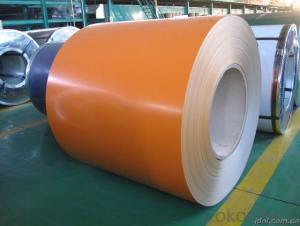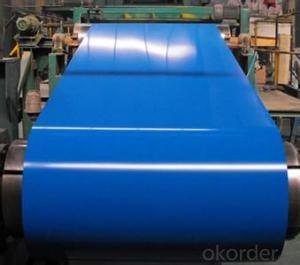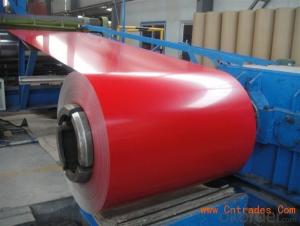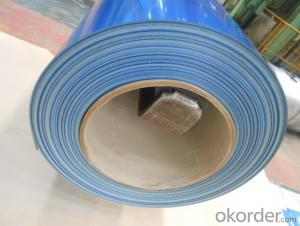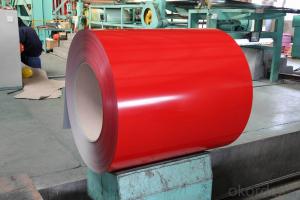Prepainted Galvanized Steel-CGC340--Excellent Process Capability
- Loading Port:
- China main port
- Payment Terms:
- TT OR LC
- Min Order Qty:
- 50 m.t.
- Supply Capability:
- 10000 m.t./month
OKorder Service Pledge
OKorder Financial Service
You Might Also Like
Prepainted Galvanized Steel-CGC340--Excellent Process Capability
Brief Introduction
Prepainted Galvanized Steel usually refers to have substrateprocessed with surface processed and coated then(roller coated )or bonded organic thin film and baked, and it is able to be processed tofinal prodevtion .
PrepaintedGalvanized Steel qualified with excellent decorative ,formability ,corrosionresistance ,coating adhesion ,can keep for a long time as well as maintainfresh color .For color coated steel sheet can obtain good economicbenefit by steel belt wood ,efficient in construction and save energy ,preventpollution etc.Which is an ideal material;for manufacturing board.
Specification:
Thickness: 0.15-0.8mm
Width: 600-1250mm
Length: on request
Zinc coating: 30-275g/m2
Color: RAL series
Paint: PE, PVDF, PU
Images
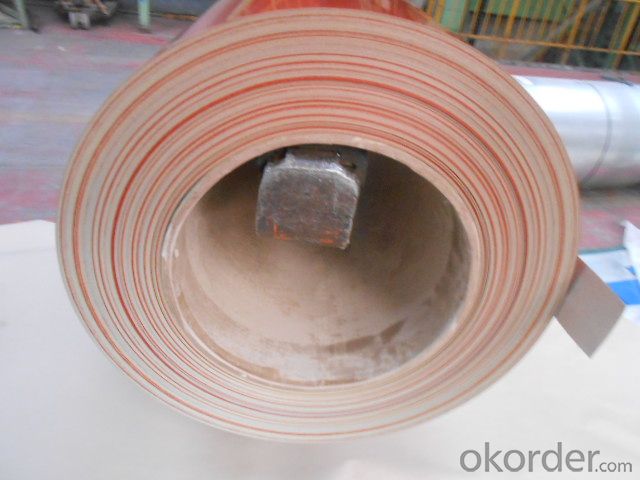
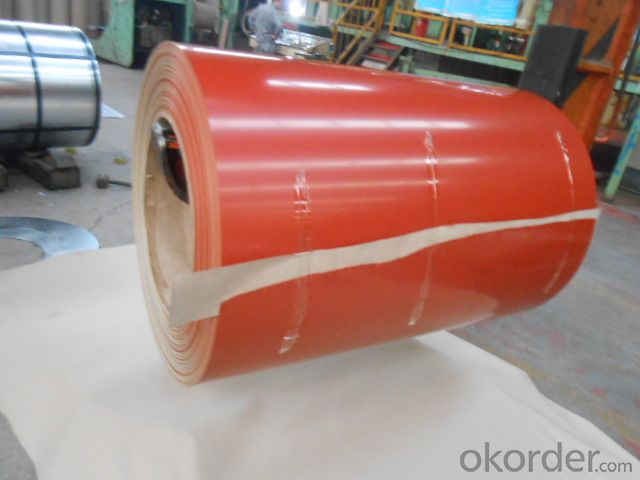
Application:
1.Buildings and constructions:roofing, ceilings, gutters, venting lines, indoor decorations,windowframes, etc
2.Electrical appliances:computer shells, washing machines, refrigerators, dehumidifiers,videorecorders, water heaters, etc.
3. Agriculturalequipments: troughs, feeding tools, agricultural driers, irrigation channels,etc.
4. Vehicle parts: back-seat plates of buses and trucks, conveying systems, oil tanks, etc.
Advantages:
1. High strength
2. Well rainproof performance
3. Good corrosion
4. Easy to install and remove
5. FAQ
1.How to guarantee the quality of the products?
We have established the international advanced quality management system,every link from raw material to final product we have strict quality test;We resolutely put an end to unqualified products flowing into the market. At the same time, we will provide necessary follow-up service assurance.
2. How long can we receive the product after purchase?
Usually within thirty working days after receiving buyer’s advance payment or LC. We will arrange the factory manufacturing as soon as possible. The cargo readiness usually takes 15-25 days, but the shipment will depend on the vessel situation.
- Q: Is it just because brass is reloadable? But what makes it reloadable? What does brass bring to the equation that the steel cased ammo can't do?
- When 9mm was short I bought some steel Tula ammo, it was cheap and available. When at the range I was shooting it and it sounded different and felt different, way less kick. So I loaded up a mix of Tula and some Federal. Big difference between them. I also had failure to eject on the steel, then put brass in and did not have that problem. I do not buy cheap steel ammo anymore.
- Q: Don't ask me why, but I took my stainless steel ring and I heated it up with my gas stove. I stuck it in there til the metal turned red, and the flame which is normally blue turned orange for some reason when the metal turned red. Anyway, afterwards i cooled it off in water and now it's all discolored and it feels different. It's weighs less and it doesn't feel the same. Plus, it's ugly cause it's all black and blue. What happened? Someone help
- You oxidized it. There is nothing you can do to recuperate the oxidized metal. The best you can do is to polish off the rust with a commercial metal polish paste.
- Q: How do steel coils contribute to the manufacturing of appliances?
- Steel coils play a crucial role in the manufacturing of appliances. These coils are typically made from high-quality steel and are used in various stages of appliance production. Firstly, steel coils are used in the fabrication of appliance components. Manufacturers use these coils to create the outer and inner casings of appliances such as refrigerators, washing machines, and dishwashers. The sturdy nature of steel ensures durability and provides a protective barrier for the inner workings of the appliance. Moreover, steel coils are utilized in the production of appliance parts. These coils are often cut, shaped, and formed into smaller components like brackets, frames, and panels. These parts are essential for the proper functioning of appliances and contribute to their overall performance and longevity. Steel coils also contribute to the manufacturing of appliance doors. The coils are molded and shaped to create the doors, which are crucial for the accessibility and safety of the appliance. Steel doors offer strength, security, and insulation, making them an ideal choice for appliances. Furthermore, steel coils are used in the manufacturing of heating elements and burners in appliances like stoves and ovens. These coils are designed to withstand high temperatures and provide efficient heat transfer, ensuring the appliances can cook or bake food effectively. Overall, steel coils are an integral part of the appliance manufacturing process. They are used to create the outer casings, essential components, doors, and heating elements of appliances. The use of steel in these applications enhances durability, safety, and overall performance, making appliances more reliable and long-lasting.
- Q: Can steel coils be coated with vibration-damping materials?
- Yes, steel coils can be coated with vibration-damping materials. The application of vibration-damping coatings can help reduce the transmission of vibrations and noise, enhancing the performance and durability of steel coils in various applications.
- Q: What are the different methods of heat treatment for steel coils?
- Steel coils can undergo various heat treatment methods, each offering unique benefits and applications. One method is annealing, where steel coils are heated to a high temperature and gradually cooled in a controlled environment. This relieves internal stresses, enhances ductility, and refines the grain structure, resulting in softer and more machinable steel. Another method, normalizing, is similar to annealing but involves a faster cooling process. It aims to refine the grain structure and achieve uniform hardness throughout the coils. Normalizing also eliminates residual stresses and improves mechanical properties. Quenching and tempering is a two-step process that begins with heating the coils to a high temperature and rapidly cooling them in a quenching medium like oil or water. This creates a hard and brittle phase called martensite. To enhance toughness and reduce brittleness, the coils are reheated to a lower temperature and held there for a specific duration, a process known as tempering. Tempering helps decrease internal stresses and increase ductility and toughness. Case hardening is another method used to increase the surface hardness of steel coils while maintaining a soft and ductile core. This involves heating the coils in a carbon-rich atmosphere, allowing carbon to diffuse into the surface layer. The result is a hard outer layer, known as the case, while the core retains desired mechanical properties. Stress relieving is performed by heating the coils to a specific temperature and holding them there for a sufficient time. This minimizes residual stresses from previous manufacturing or heat treatment processes. Stress relieving improves dimensional stability, reduces the risk of distortion or cracking, and enhances overall performance. The choice of heat treatment method depends on desired properties, intended application, and specific requirements of the end product. Each method has its own advantages and can be customized to achieve the desired balance between hardness, toughness, ductility, and other mechanical properties.
- Q: steel can be used to do?
- I also know that jawaysteel this company, they're really good
- Q: is red steel any good??????? not sure im really impressed but im not really into fighting games but it looks cool.... so whats your views guys???????anyone bored of smooth moves yet?anyone think the new sonic is bit cra ppy !!!!!!!!!!! darn them any new goooood games coming oput on the wii??
- Have you tried Zelda or Trauma Center? Those should give you a good ride for your money. If you have a few bucks lying around pick either of them up.
- Q: How do steel coils contribute to energy efficiency in lighting?
- The energy efficiency of lighting relies heavily on the type of light source chosen, such as incandescent, fluorescent, LED, or halogen bulbs. Each of these light sources consumes energy differently. On the other hand, steel coils serve a different purpose in lighting fixtures. Their main function is to provide structural support, dissipate heat, and protect the components. They do not have a direct impact on the energy efficiency of the lighting system. However, steel coils can indirectly improve energy efficiency by offering sturdy support to the fixtures. This ensures that the installations are reliable and long-lasting, reducing the need for frequent maintenance and replacements. A well-supported lighting system guarantees optimal performance and minimizes energy wastage or inefficiencies caused by loose or unstable fixtures. Furthermore, steel coils can also be used to manufacture reflectors or housings for lighting fixtures. These components play a role in enhancing the overall efficiency and distribution of light. By effectively reflecting and directing the light output, energy utilization and illumination can be optimized, resulting in reduced energy waste. Although steel coils themselves do not directly influence the energy efficiency of lighting, their incorporation in the construction and support of lighting fixtures indirectly contributes to a more energy-efficient lighting system.
- Q: Hey I just got a mini 14 manufactured in 1980. I also had some .223 Wolf steel cased HP rounds (about 200) that i could shoot throught it, but I was just wondering if its a bad idea to use this steel cased ammo...? Only the casing is steel i believe... and the bullet is copper jacketedthanks for your help
- Wolf's steel cased ammo isn't bad as practice/plinking ammo, especially for the price, as long as you give your weapons MULTIPLE, THOROUGH cleanings between uses, to be sure and remove ALL the gas fouling left by the Wolf components. HOWEVER.................. As Wolf steel cases are lacquer coated, DO NOT leave a round in a hot chamber, even during short pauses between stages of fire on the range, as the lacquer coating WILL melt, and cause the round to seize in the chamber, causing extraction and jamming problems, especially if the weapon is allowed to cool down with the round left in the chamber. Be extra diligent in removing this lacquer fouling when cleaning the weapon later. I have personally seen other shooters have the case rims ripped off spent cases in the chambers, causing a trip to the gunsmith to have the stuck case removed without damaging the weapon's chamber and actioin, at no minor expense.
- Q: I'm in the process of buying a new car, and wondering if there are more benefits from Aluminum tire rims over Steel. Aluminum wheels cost more, but you'd think that steel would last longer. Are Aluminum wheels just for looks?
- If you got money to waste get the aluminum. Practicality is the steel wheels.
Send your message to us
Prepainted Galvanized Steel-CGC340--Excellent Process Capability
- Loading Port:
- China main port
- Payment Terms:
- TT OR LC
- Min Order Qty:
- 50 m.t.
- Supply Capability:
- 10000 m.t./month
OKorder Service Pledge
OKorder Financial Service
Similar products
Hot products
Hot Searches
Related keywords















